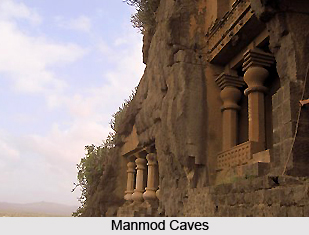Manmod Caves in Maharashtra, is a group of 45 caves that are rock cut temples of the Jain and Buddhist religion, that were created between 1st and 3rd century AD. There are almost 200 caves around the Junnar region, amongst which the Manmod Caves comprises the main part. The Lenyadri Caves, Tulja Lena and Shivner Caves are also in that region. There are various remnants of artefacts and paintings in the caves. There are also paintings from the 10th - 11th centuries that can be found in Cave II.
Manmod caves in Junnar, which was a major trade hub of the 1st century AD, mainly housed Buddhist monasteries that were made roughly around 2000 years ago. These were designed according to the Hinayana traditions. The caves are made in 3 segments or groups, Bhimashankar Group, which comprises of 10 caves, is in the eastern region, the Bhutling Group, which comprises of 16 caves, is on the north-west side, and the Ambika Group, comprises of 19 caves, is in the middle.
 Bhimasankar Group
Bhimasankar Group
Bhimasankar Caves are situated near the Dudhare Hill, in the east. Cave I was made as lodging for monks, called layana. There is a verandah with 3 different cells. Cave II was created as a shrine or Chaitya, and has an incomplete structure of a woman in a seated position, along with an abandoned shrine and two pillars. The cave was plastered and contains paintings on the ceiling of verandah and hallway. Cave III has dinning area and a verandah. There is also a reservoir in the front area. Cave IV contains a verandah along with two decorated pillars, as well as cell. The cave is mostly unfinished. There is an inscription in Cave VI that was made by Ayama, prime minister of King Nahapana in 124 AD. There is a row of seven cells in Cave VIII. Cave X contains an unfinished cell and a verandah.
Ambika Group
The caves in the Ambika Group are situated in the north of the Bhimasankar Group, almost 250 m away. As Cave XVI hosts a statuette of goddess Ambika, thus it was named after the goddess. There are seven reservoirs, which are still in use till today. Cave XI is basically a vihara and is partly damaged. There is a verandah in Cave XII but this is also an unfinished vihara. Cave XIII is in similar state. There is a hallway along with two cells in Cave XIV, and is damage to some extent. It is assumed that Cave XV was utilised to house cattle. Cave XVI is a Jain monastery, and there is sculpture of goddess Ambika, of the Jain religion. There are five cells and a huge verandah; there are more sculptures from the 10th - 11th century. Statues and figures of gods like Tirthankar, Chakreshvar, Adinath and Neminath are also present. Cave XVIII and Cave XIX are mostly damaged and collapsed, and contains a cell and verandah. Other caves consist of artworks from Buddhist religion as well. There is also a shrine that was made around 50 AD. Most other vcaves house shrines, and consists of a verandah and hallway. There are remnants of plaster made by paddy and mud.
Bhutling Group
The caves in the Bhutling group are north-east facing and are almost 200 m away from the previous group. Cave XXX is a vihara, but is unfinished. Cave XXXII is a lodging area and contains four cells. This part is badly ruined. Cave XXXIII is also a vihara and has seven separate cells. Cave XXXIV has a number of four cells and a verandah. Cave XXXVI which is also a vihara, has a verandah and four cells. The cells can be reached via a door. The inner area is decorated with various artworks, like a Buddhist wheel. Cave XXXVIII is an uncompleted chapel, which is the biggest structure in the Bhutling Group. There is a patio right above the verandah, decorated with sculptures of flowers, animals and Lakshmi and other figures. Cave XL is mostly malformed, and only cells are present. The other caves are further apart from the main group. These caves mostly contain a verandah, an incomplete cell and were mainly used for lodging purposes.



















